Ghee is a kind of clarified butter that’s conventional in Indian delicacies. This nutty flavored and excessive smoke level fats has been used for 1000’s of years, with deep roots in Ayurvedic practices. Making desi ghee at residence is easy, simple and price efficient and can render significantly better taste than commercially out there varieties. Comply with together with me as I present you the right way to make ghee recipe within the conventional Indian manner with the assistance of step-by-step pictures and video.
All About Ghee
Ghee is a form of clarified butter extensively utilized in Indian cooking. It’s made by gently simmering unsalted butter till the milk solids separate, caramelize, and the moisture evaporates.
What’s left is a transparent, golden fats that’s strained to take away the browned solids. This clarified butter has a nice aroma, refined nutty style, and excessive smoke level, making it nice for stir-frying, sautéing, and deep frying.
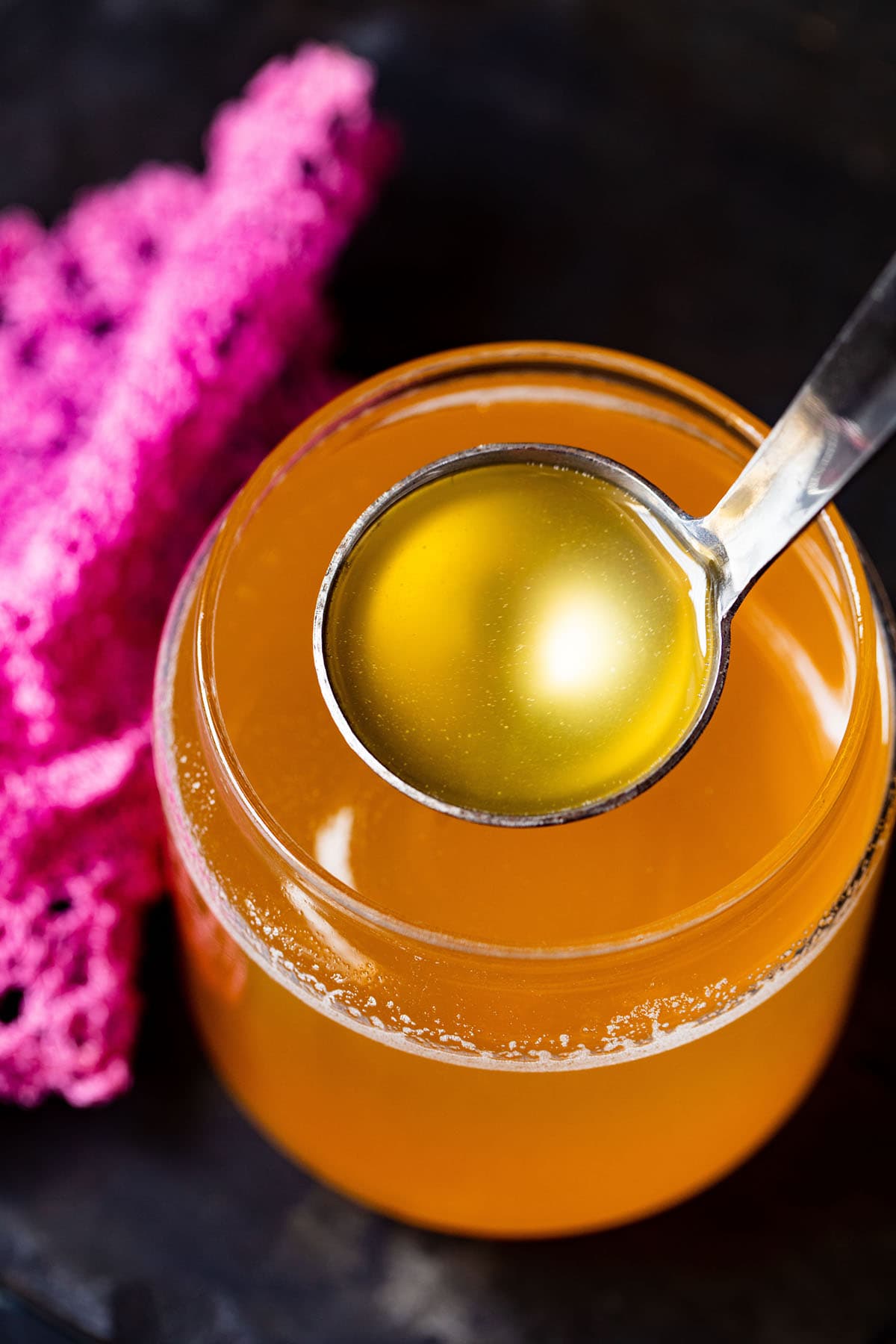
Historically made at residence, ghee is valued not only for its style and flexibility, but in addition for its lengthy shelf life. It enhances each candy and savory dishes throughout Indian delicacies.
Ghee has been made in India for hundreds of years and is extensively used within the Indian delicacies. It has a a lot larger smoke level than common butter, making it a wonderful fats for prime warmth cooking.
It additionally occurs to be shelf steady (that means no refrigeration is required) and is even acceptable for individuals with lactose intolerance.
Ghee can also be lauded as an Ayurvedic superfood with anti-inflammatory and digestion aiding properties.
Excessive in Omega-3 and -6 fatty acids, DHA, in addition to in nutritional vitamins A, D, E and Ok, this butterfat breaks the mildew and is even being accepted as a healthful meals by western medication requirements.
Ghee is so necessary to each Indian delicacies and identification. It’s thought-about to be one of many highest providing within the fireplace rituals which can be known as as as Havan or Homam within the Hindu tradition. Ghee can also be part of panchamrit that’s provided to the deities.
Do observe that the desi ghee provided within the havan ritual must be constituted of cow’s milk and never buffalo’s milk. Cow’s milk is taken into account satvik and buffalo’s milk is taken into account tamasic.
Now that you know the way great ghee may be, let’s set about studying the right way to make ghee at residence, we could?
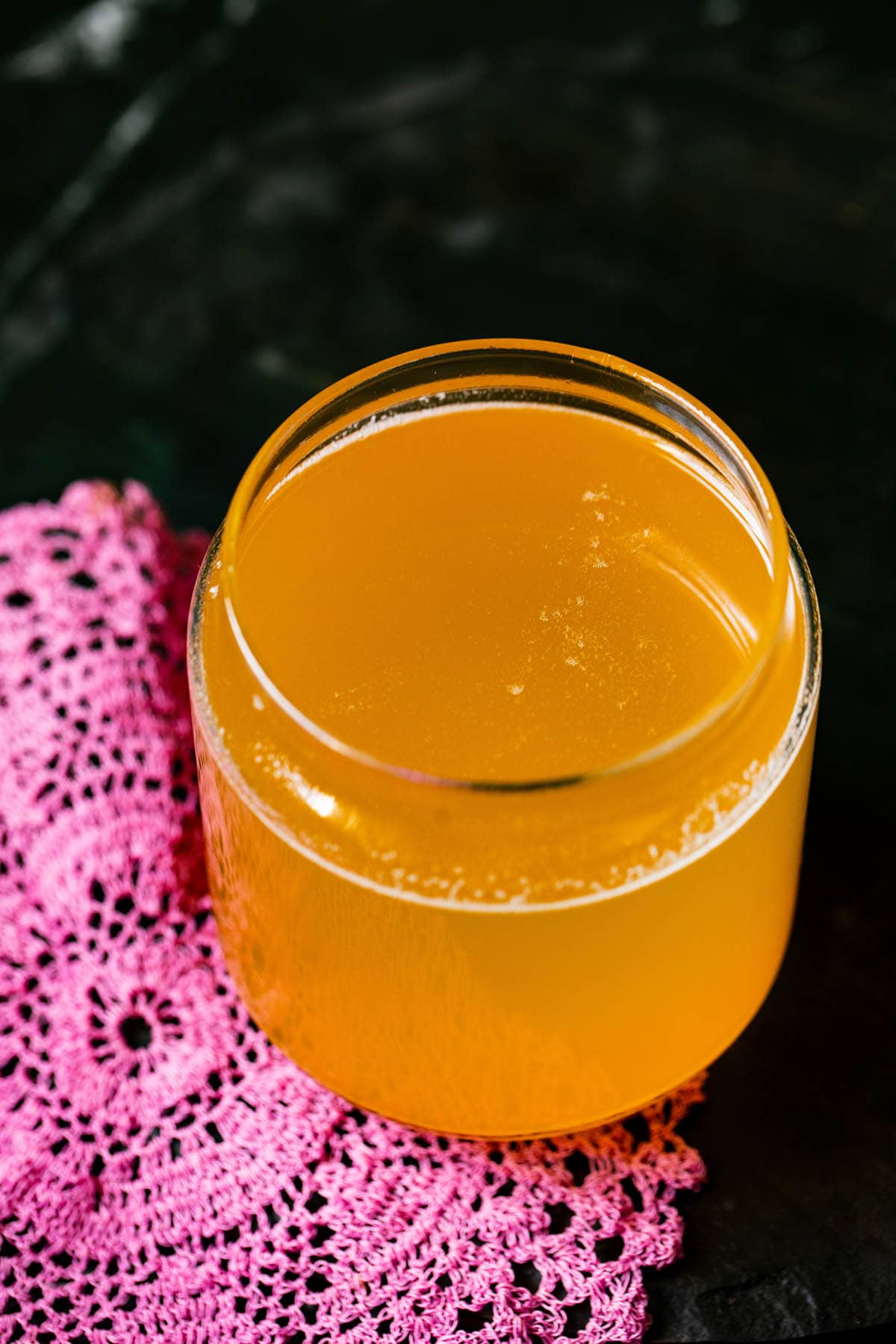

The Significance of Utilizing Cultured Butter
Historically, desi ghee recipe is constituted of cultured cream or curd (yogurt) that comes from regionally sourced, grass fed Desi cows.
This cultured cream or yogurt is then churned to get cultured butter. Solely then is the butter heated and sluggish simmered to get ghee.
There was a time I might comply with the age-old course of of creating home made cultured butter to make use of for making ghee. Now, on account of lack of time, I exploit store-bought unsalted cultured butter.
For this ghee recipe, be sure you procure unsalted, grass fed and ideally natural butter from Desi cows, as this can end in essentially the most conventional tasting ghee and will likely be simple to digest.
In simply 20 to 25 minutes you’ll be able to have stunning home made ghee that’s so significantly better tasting (and more healthy for you!) than pre-packaged varieties.
Together with home made ghee, you may as well discover ways to make these dairy necessities at residence:
Find out how to Make Ghee
This recipe for making home made ghee recipe is kind of easy. That stated, please observe that it’s best to stay in your kitchen for the whole lot of this course of.
Ghee can go from caramelized to burnt in a flash! Keep attentive and vigilant so that you get the highest quality ghee round.
I’ve additionally learn that one ought to make desi ghee in the course of the full moon. The energies of the moon are infused within the ghee should you make it on a full moon day.
Let’s start with the right way to make ghee from butter at residence.
Soften Butter
1. Seize a big, heavy-bottomed pot or pan. Chop butter roughly and place within the pan overlaying the whole floor of the pan evenly. For this ghee recipe, I’ve used a 3 litre (3.17 quarts) pot.
For this ghee recipe, I’ve used 500 grams of unsalted cultured butter. You would scale the recipe to make a small or huge batch by utilizing any quantity of butter. In the event you plan to make a bigger batch, be sure that to make use of a big pot or pan.
Tip: The pot needs to be massive and heavy. A smaller pan will trigger the melted butter to spill over whereas effervescent and frothing. A lighter skinny bottomed pan could make the butter or ghee burn too quick.
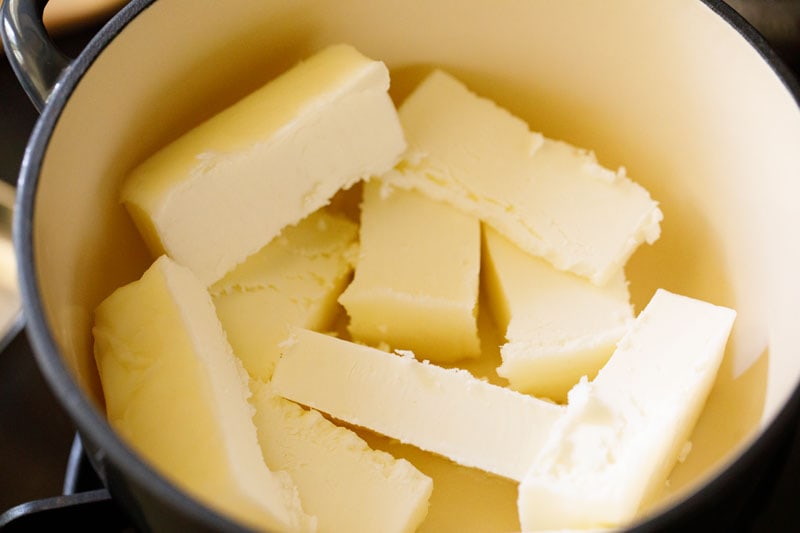

2. Place pan on stovetop and warmth on medium-low to medium warmth. The butter will start to soften.
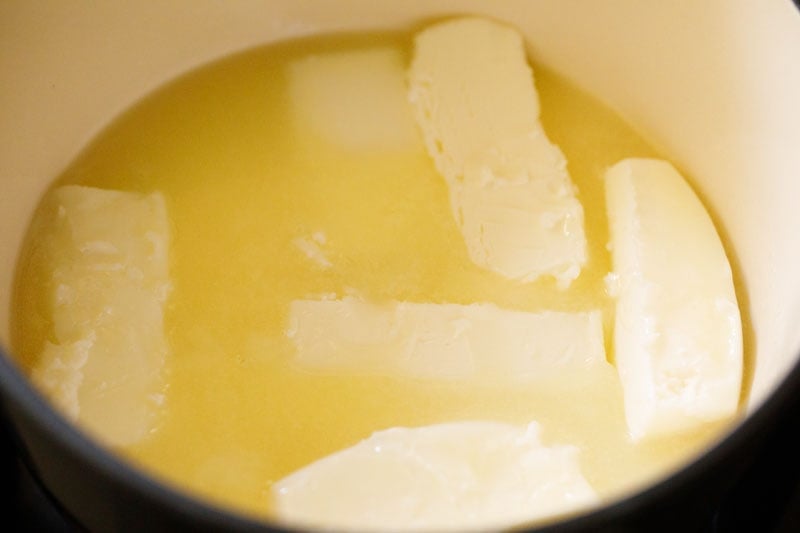

3. Stir in intervals when butter begins to soften to help the bigger items.
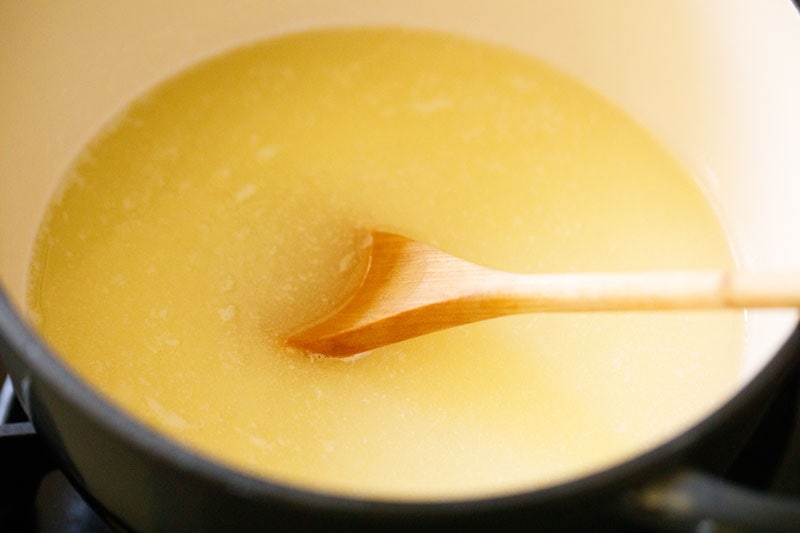

Simmer Butter
4. When all of the butter has melted, cut back warmth to the bottom setting and simmer gently.
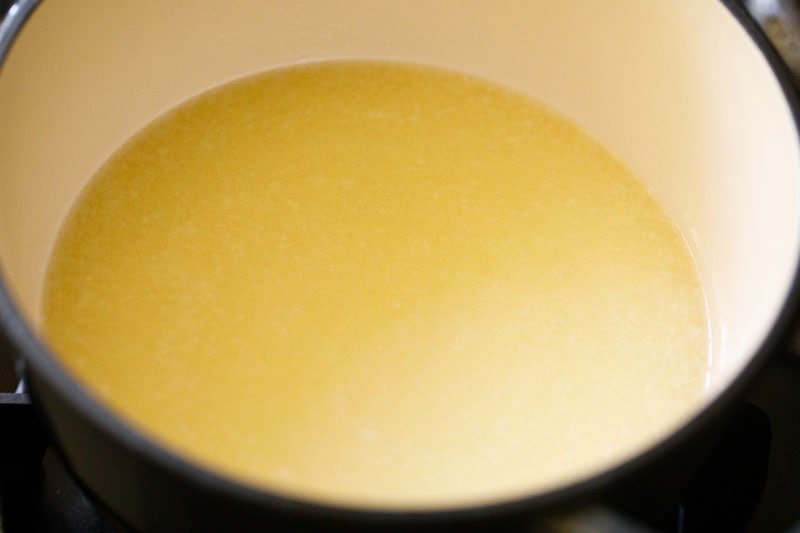

5. A couple of minute or so after all of the butter is melted, you’ll hear sounds from the underside of the pan and see milk solids showing on the floor.


6. Your entire floor will likely be coated with milk solids. Proceed to simmer.
You will notice the colour change progressively to a from a buttery, pale yellow to gentle golden with the butter effervescent and shimmering.
The effervescent and frothing is because of the water current within the butter.
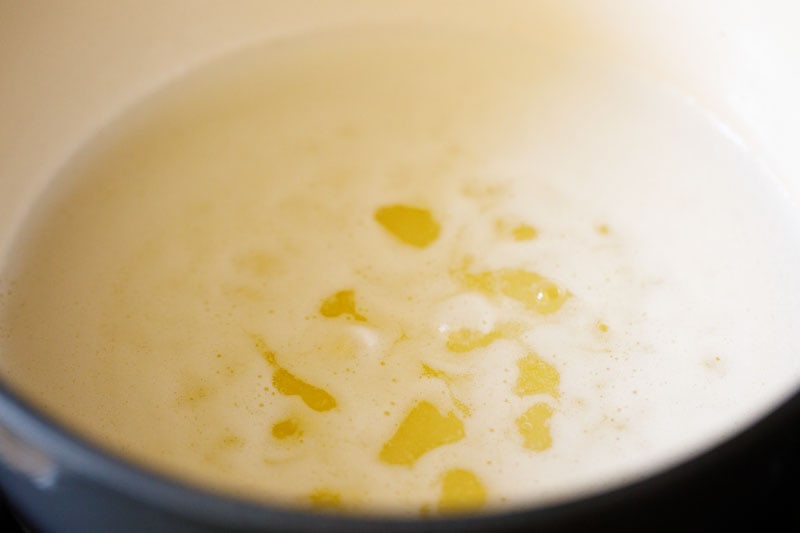

7. Proceed to stir often.
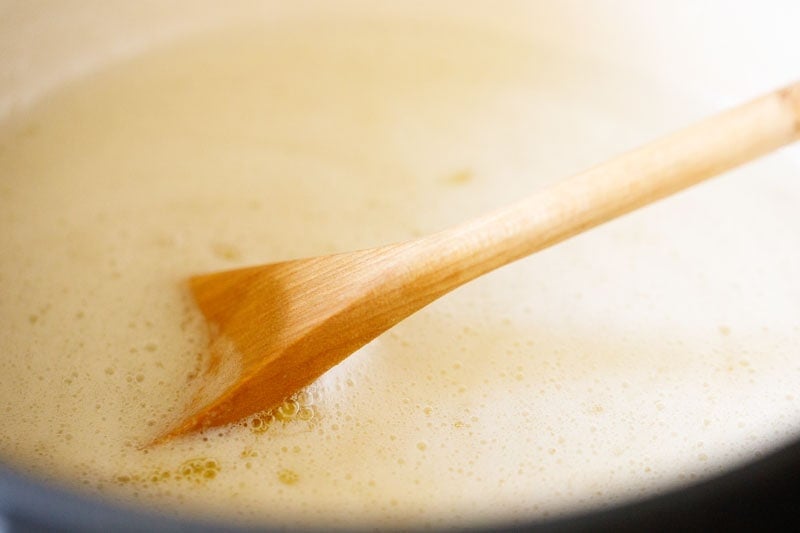

Make Ghee
8. After a while, the milk solids will start to settle on the backside and the floor will begin to look clearer.


9. Proceed to simmer for a few minutes after all of the milk solids have settled.
Tip: I desire to make use of a light-weight coloured pan in order that I can see the colour of the milk solids on the backside once I stir.
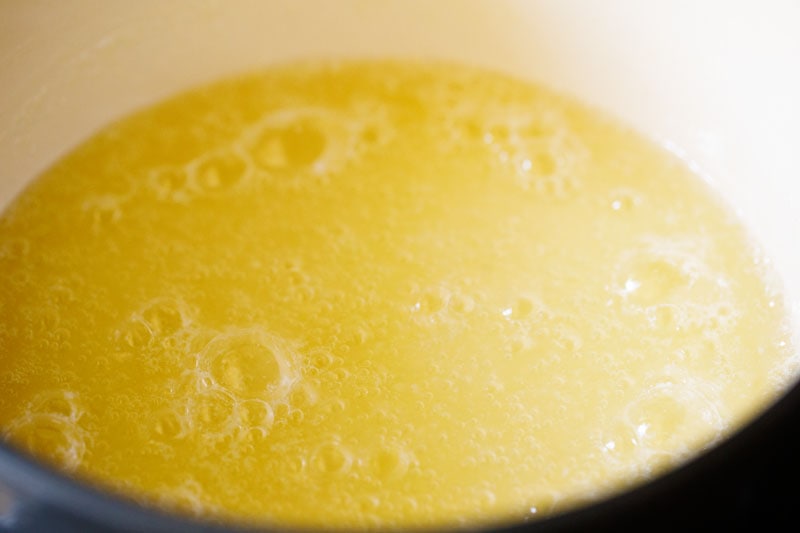

10. Once you see medium to massive sized bubbles forming on the highest and the whole combination is effervescent, you’re virtually achieved! Proceed to simmer for a 1 to 2 minutes extra.
Tip: In the event you preserve the pan on the warmth for too lengthy, the milk solids will get too browned and even burnt. You should be attentive right here!
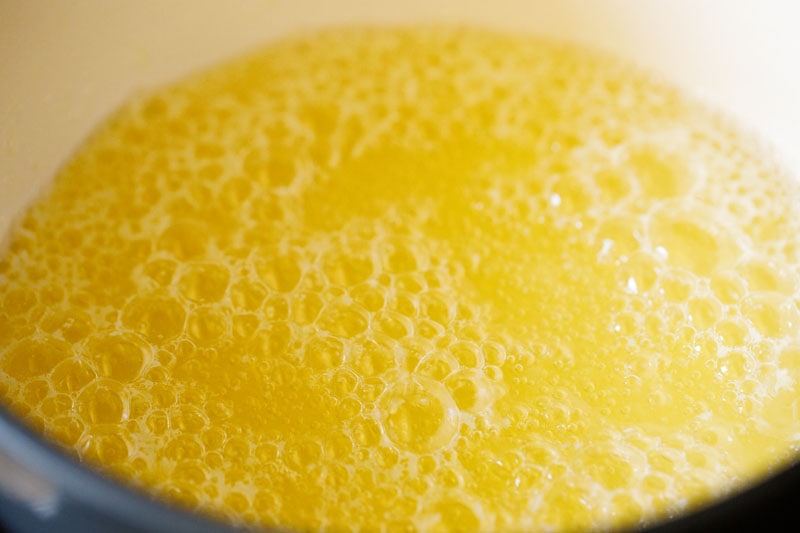

11. Take away from warmth and place the pan on the countertop. You will notice a layer of effective tiny bubbles on the highest. Don’t fear – these bubbles go away because the ghee progressively cools.
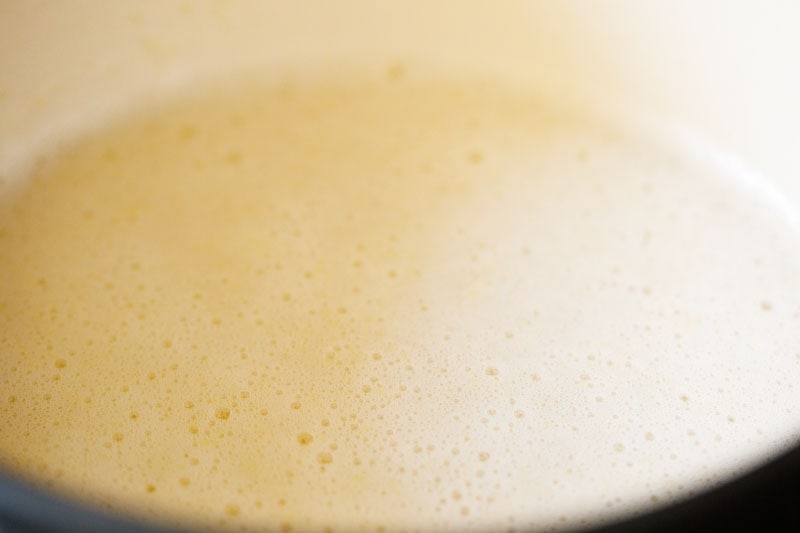

12. The milk solids will start to caramelize and switch golden from the residual warmth, and you will note the colour of ghee turn into darker.
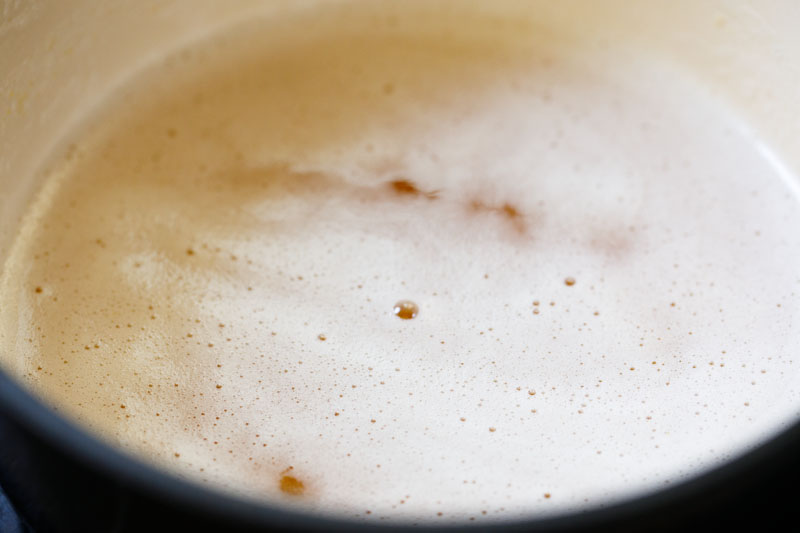

13. Wait till all of the simmering stops and also you see the browned bits of milk solids on the backside.
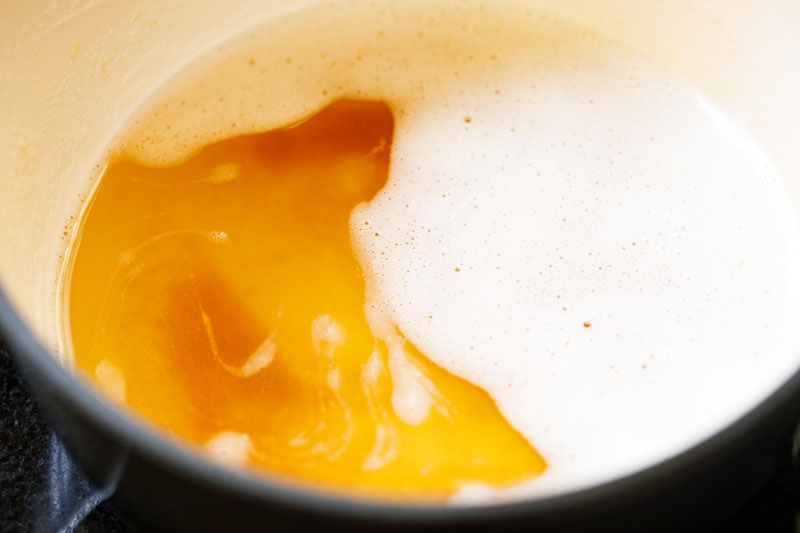

14. Right here is one other picture of the browned milk solids.
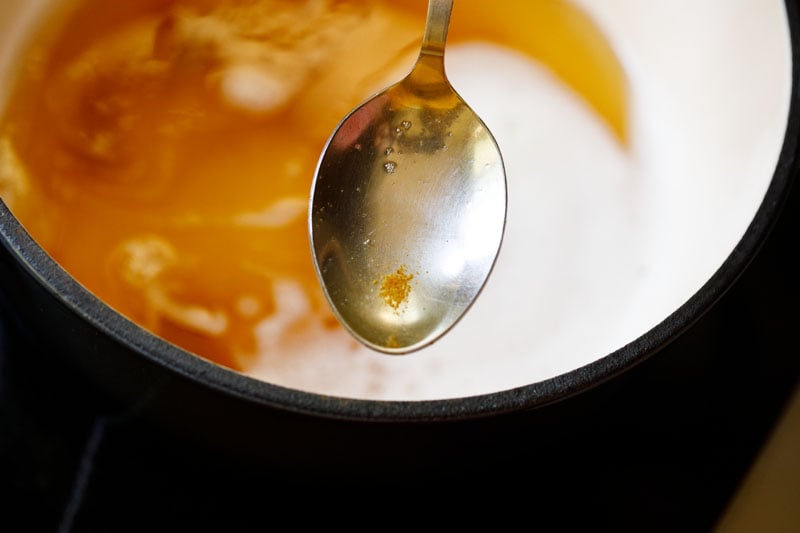

Pressure
15. Whereas the ghee remains to be scorching, pour it by means of the strainer or cheese material positioned on prime of a glass jar. In case your pan isn’t very heavy, merely carry it and pour the ghee. I used a heavy ceramic coated forged iron pan, so utilizing a ladle made this course of simpler.
Tip: Make certain the glass jars are warmth proof because the ghee will likely be scorching and might shatter glass that isn’t tempered! I discover mason jars are excellent for this. Or you need to use metal jars.
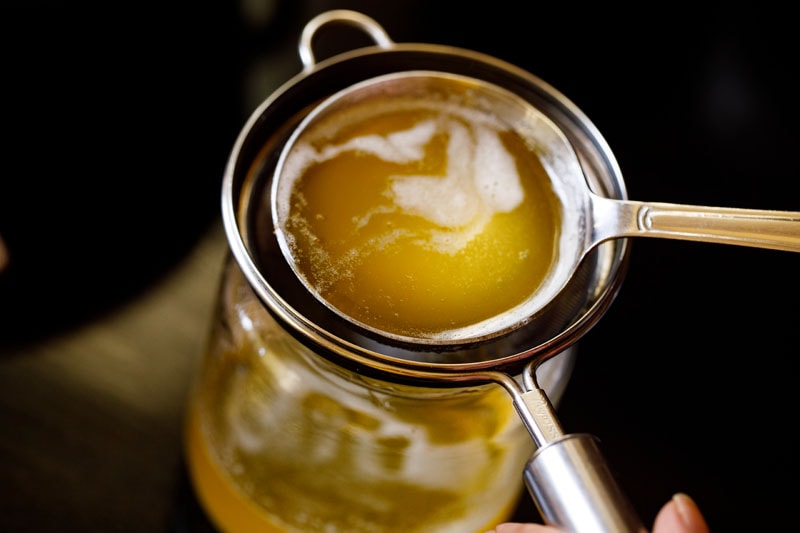

16. Right here’s the liquid gold ghee in a jar. Shut tightly when the ghee cools. Retailer in a cool dry place.
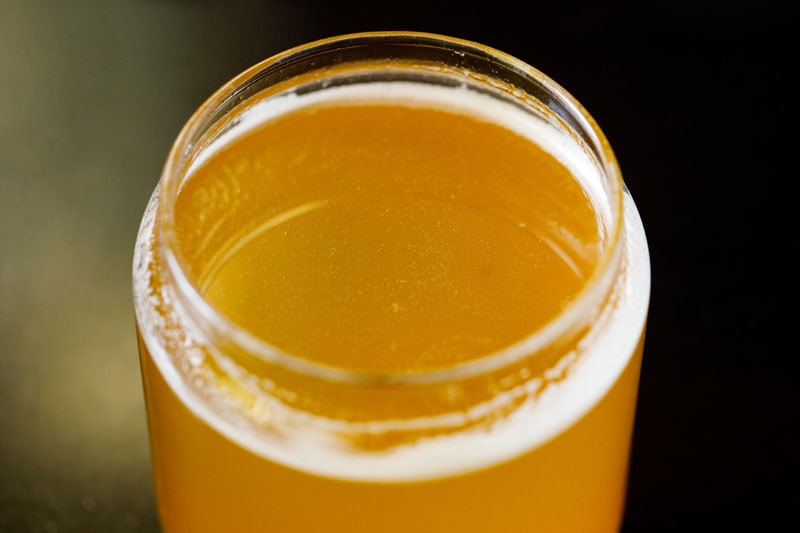

Storage Options
Use ghee as wanted. I like to recommend pulling out sufficient ghee for every week or so price of cooking and maintaining it in a small container within the kitchen. I normally make ghee from 500 grams butter, which normally lasts me for a couple of month or so.
Retailer the remainder in a cool, darkish spot within the pantry for greatest storage. If saved properly, ghee can last as long as one yr at room temperature.
In hotter climates, refrigerate it to increase shelf life. All the time use a clear dry spoon to take away ghee so that you just don’t find yourself contaminating it.
When you get the nuances and method proper, making ghee at residence turns into simple and easy. And when you know the way to make ghee, you’ll be able to put together it anytime, wherever.
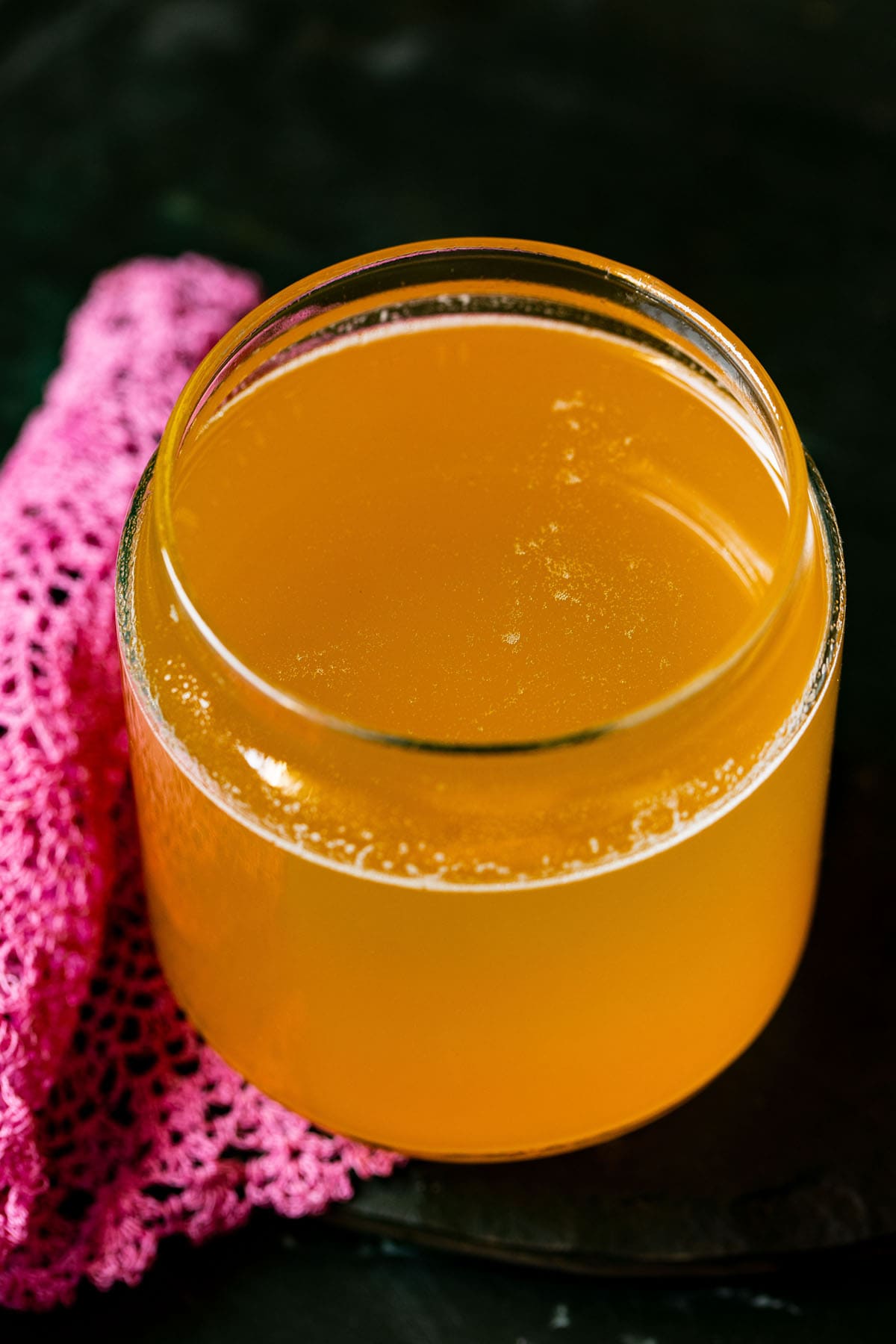

What Can I Make With Ghee
Loads of Indian meals is made in ghee. We not solely use ghee because the fats to make lentils, curries, veggies and rice based mostly dishes but in addition make lots of our sweets with it. Understanding the right way to make ghee at residence is very helpful in an Indian kitchen.
It’s the popular fats in Indian cooking (even over butter and oil), particularly for sweets and dishes like Biryani and wealthy curries.
- Use it to sauté, stir-fry or roast your veggies. The excessive smoking level of ghee helps if you stir fry, bake or roast veggies at the next temperature.
- Toast your bread with it, or unfold it instead of butter in your toasted bread. You can be stunned at how good toast may be with ghee! It’s considered one of my favourite methods to eat toasted bread.
- Add a couple of spoons on prime of Indian meals like Khichdi, Dal Tadka, Kadhi whereas consuming. The great fat in ghee helps to digest the meals simply.
- Unfold it in your Roti or Naan or Pita Bread.
- Roast Paratha in ghee as an alternative of oil.
- Make your Bread loaves and dinner rolls with ghee because the fats.
- Use it in Indian sweets like Carrot Halwa, Kheer, Besan Ladoo and plenty of extra.
- Deep fry your meals in it.
- Bloom or mood your spices in it.
You can too use ghee for the Ayurvedic apply of oil-pulling!
Totally different Methods of Making Ghee
Whereas I normally comply with the straightforward recipe above for making ghee rapidly, there are different methods of creating it as properly. Ghee recipe may be constituted of cream or yogurt as properly! Learn on beneath to see the way it’s achieved.
Find out how to Make Cultured Butter from Malai or Cream
I used to make ghee with this Do-it-yourself Butter. Whereas it is vitally scrumptious, it’s far more time consuming than utilizing bought cultured butter.
You start by first gathering the cream that floats on prime of milk after it’s boiled and cooled. Hold gathering these layers of cream (known as malai in Hindi) in a freezer secure field. Retailer coated within the freezer.
When you have got about 2 to three cups of this cream, take away it from the freezer and place the container of it in your fridge in a single day.
The subsequent day, take away the cream from the fridge. Add ¼ cup curd (yogurt) to 2 cups cream and blend properly. Hold it at room temperature for 9 to 12 hours. It will add some good bacterial tradition to the cream and the cream will thicken and set.
I discover the Instantaneous Pot useful on the subject of setting and culturing the cream. Use the yogurt settings and set the time to 9 hours on regular mode. You don’t want to heat the cream earlier than including the yogurt.
When your cultured cream is prepared (after 9 to 12 hours), pour all of it in a blender or stand mixer. Add about ¼ to ½ cup ice chilly water and mix till the butter separates from the cream.
Once you see the butter separating, acquire the butter with a strainer or clear fingers draining all of the buttermilk.
Tip: Don’t toss the liquid! Retailer the buttermilk and use it to make pancakes or desserts, muffins, or breads.
You now have home made cultured butter. Both refrigerate it or use it straightaway to make ghee utilizing the steps for the recipe above.
Ayurvedic Technique of Making Ghee with Curd
The Vedic or Ayurvedic methodology of creating butter for ghee is totally different than mixing cream. The ghee recipe right here is constituted of curd (yogurt) that’s made with the milk from grass fed indigenous Desi cows, and never the extra frequent jersey cows.
This course of additionally requires a specialised hand churner known as a ‘bilona’ (pronounced BEE-low-na).
The curd is added to the bilona pot and is then hand churned by pulling a rope that strikes the rod each clockwise and counter-clockwise.
It’s this shifting of the rods in reverse instructions that assist to separate the butter from the curd. The method of churning in reverse instructions is named ‘manthan‘ in Hindi.
Lately, the method of creating Ayurvedic ghee has been commercialized by means of the usage of engine pushed bilonas.
Do not try this in a blender as you received’t get any butter. Belief me! I’ve tried and failed. The blender blades transfer in just one course, and in consequence the butter doesn’t separate. So fascinating, proper?
Making Ghee from Cream
Ghee will also be made with cream that hasn’t been was butter. The cream is sluggish cooked and simmered till the milk solids separate, then caramelize and also you get the golden coloured ghee. Simply observe that this means of cooking the cream takes extra time than should you use butter as an alternative.
For higher taste and digestion, you’ll be able to tradition the cream earlier than making ghee. To tradition the cream, add a couple of teaspoons of curd or yogurt to it and let it sit at room temperature for six to eight hours or in a single day.
This fermentation step enhances the flavour of the ghee and can also be believed to make it simpler to digest. As soon as the cream has developed a slight tang, you’ll be able to proceed to churn it into butter or cook dinner it straight into ghee.
Professional Ideas
- Flavoring: Some individuals prefer to infuse ghee with flavors like moringa leaves, betel leaves, or curry leaves. To do that, add a couple of strands of any of those leaves proper after turning off the warmth and putting the pan on the countertop. The leaves will cook dinner within the residual warmth, flip crisp, and launch their aroma into the fats. Pressure the ghee and discard the leaves or stems.
- Pan Sort: I desire utilizing a light-colored pan so I can simply monitor the colour of the milk solids as they cook dinner. All the time use a heavy or thick-bottomed pan to forestall the butter from burning.
- Be Attentive: Keep away from overheating the ghee. If left on the warmth for too lengthy, the milk solids can brown an excessive amount of and even burn. Keep attentive in the course of the closing stage.
- Jars for Storing Ghee: Use heatproof glass jars since scorching ghee can crack common glass. Mason jars work properly for this. You can too retailer ghee in clear, dry metal containers.
- Scaling: I normally make home made ghee utilizing 500 grams of unsalted butter, however you’ll be able to scale the amount up or down as wanted.
- Storage period: Ghee stays good at room temperature for a couple of yr when saved correctly. In hotter climates, you’ll be able to refrigerate ghee to assist it last more.
- Use a clear spoon: All the time use a clear, dry spoon to keep away from contamination and spoilage.
FAQs
What’s the distinction between ghee and clarified butter?
Ghee is typically used interchangeably with the time period “clarified butter,” however it’s really totally different from clarified butter. In ghee, the milk solids are caramelized which give it a deliciously nutty, virtually candy taste.
Clarified butter, however, refers merely to butter the place the milk solids are merely skimmed off and never caramelized.
How can I taste my ghee?
Some people prefer to taste their ghee with moringa leaves or curry leaves. In order for you a flavored ghee, then add a couple of strands of both moringa leaves or curry leaves if you place the ghee pan on the countertop.
The leaves cook dinner and turn into crisp, releasing their flavors within the fats. Pressure the ghee and discard the stems or leaves.
How lengthy will ghee final?
If saved appropriately, ghee can final for as much as a yr with out refrigeration. Make sure to preserve it away from warmth, gentle and something that may introduce micro organism. If the ghee begins smelling “off,” scrape away the highest layer and transfer it to the fridge for safer storage.
Can I eat ghee if I’m lactose illiberal?
Sure! The method of creating and straining the ghee removes the lactose and casein from the fats, making it completely appropriate for lactose illiberal people.
Prepare dinner and Simmer Butter
-
Take a big, heavy-bottomed pot or pan. Chop butter roughly and place within the pan overlaying the whole floor of pan evenly.
-
Place pan on stovetop and warmth on medium-low to medium warmth. The butter will start to soften.
-
Stir in intervals when butter begins to soften to help the bigger items. When all of the butter has melted, cut back warmth to the bottom setting and simmer gently.
-
A couple of minute or so after all of the butter is melted, you’ll hear sounds from the underside of the pan and see milk solids showing on the floor.
-
Your entire floor will likely be coated with milk solids. Proceed to simmer.
-
You will notice the colour change progressively to a from a buttery, pale yellow to gentle golden with the butter effervescent and shimmering. Proceed to stir often.
-
After a while, the milk solids will start to settle on the backside and the floor will begin to look clearer.
-
Proceed to simmer for a few minutes after all of the milk solids have settled.
Make Ghee
-
Once you see medium to massive sized bubbles forming on the highest and the whole combination is effervescent, you’re virtually achieved! Proceed to simmer for a 1 to 2 minutes extra.
-
Take away from warmth and place the pan on the countertop. You will notice a layer of effective tiny bubbles on the highest. Don’t be concerned – these bubbles go away because the ghee progressively cools.
-
The milk solids will start to caramelize and switch golden from the residual warmth, and you will note the colour of ghee turn into darker.
-
Wait till all of the simmering stops and also you see the browned bits of milk solids on the backside.
Pressure
-
Whereas the ghee remains to be scorching, pour it by means of the strainer or cheese material positioned on prime of a glass jar.
-
In case your pan is not very heavy, merely carry it and pour the ghee. I used a heavy ceramic coated forged iron pan, so utilizing a ladle made this course of simpler.
-
Use ghee as required. I like to recommend pulling out sufficient ghee for every week or so price of cooking and maintaining it in a small container within the kitchen.
-
Retailer the remainder in a cool, darkish spot within the pantry for greatest storage. If saved properly, ghee can last as long as one yr at room temperature.
- Flavored Ghee: Some individuals desire to taste the Ghee with moringa leaves or curry leaves. In the event you like flavored Ghee, add a couple of strands of both moringa leaves or curry leaves if you place the Ghee pan on the countertop. The leaves will cook dinner and turn into crisp, releasing their flavors within the fats. Pressure the Ghee and discard the stems or leaves.
- Pan sort: I desire to make use of a light-weight coloured pan in order that I can see the colour of the milk solids on the backside once I stir. Make sure that your pan or pot is heavy or has thick backside, in order that the butter doesn’t get burnt.
- Be attentive: In the event you preserve the pan on warmth for too lengthy, the milk solids will get too browned and even burnt. You should be attentive right here
- Jars for storing ghee: Make certain the glass jars are warmth proof because the Ghee will likely be scorching and might shatter glass that isn’t tempered. I discover mason jars excellent for this. You can too retailer Ghee in metal jars.
- Scaling: Whereas I make Do-it-yourself Ghee with 500 grams of unsalted butter, you need to use any amount of butter.
- Notice that the approximate diet information is for 1 teaspoon of ghee.
Energy: 43kcal | Protein: 1g | Fats: 5g | Saturated Fats: 3g | Ldl cholesterol: 13mg | Sodium: 1mg
Find out how to Make Ghee recipe from the archives was initially revealed on August 2021.

